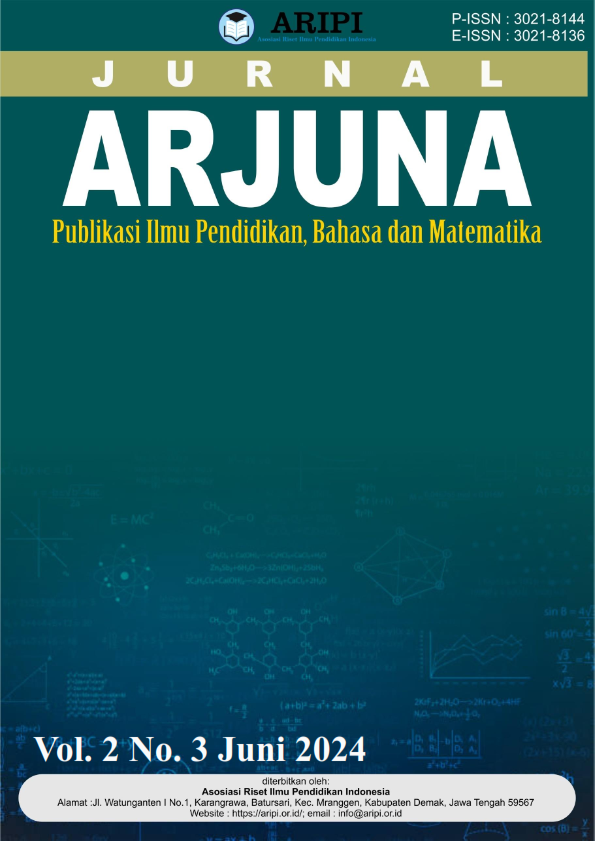Penerapan Pembelajaran Problem Based Learning Dengan Prinsip Understanding By Desain Untuk Meningkatkan Hasil Belajar Siswa Pada Mata Pelajaran Matematika
DOI:
https://doi.org/10.61132/arjuna.v2i3.803Keywords:
Problem Based Learning, Understanding by Design, Learning OutcomesAbstract
Students' mathematics learning outcomes are relatively low in Mathematics subjects. The aim of this research is to improve student learning outcomes with the Problem Based Learning learning model. PBL is carried out by applying the principles of Understanding by Design (UbD). Each cycle consists of planning, implementation, observation and reflection. This research was carried out in class VII C of SMP 8 Denpasar with 41 students as subjects. This research uses test and non-test instruments in the form of student learning outcomes tests and interviews. The results of the research carried out were that in Cycle I the percentage of students who completed was 48.78%, then in Cycle II the percentage of completion was 78.05%, because the students' grades had met the specified classical completeness so the research was stopped in Cycle II. Based on these results, it can be concluded that there has been an increase in student learning outcomes in Mathematics learning by implementing PBL with the principle of UBD.
Downloads
References
Mauldya, H. (2019). Problem-Solving ability of primary school teachers based on Polya’s method in Mataram City. PHYTAGORAS: Jurnal Pendidikan Matematika, 2, 139–149.
Muhson, A. (2006). Teknik Analisis Kuantitatif. Jurnal Pendidikan Ekonomi FIS UNY, 1–7.
Puji, T., & Setiawan, Y. (2020). Efektivitas Problem Based Learning - Problem Solving terhadap Kemampuan Berpikir Kritis dalam Pembelajaran Matematika Kelas V. Jurnal Cendekia: Jurnal Pendidikan Matematika, 04, 294–303.
Rahmah, S. (2020). Pengaruh Penerapan Model PBL Terhadap Kemampuan Pemecahan Masalah Matematika Siswa SMP PGRI Sungguminasa. Mandalika Mathematics and Educational Journal, 2, 56–66.
Resa, A. (2023). Implementasi Kurikulum Merdeka Berdasarkan Pendekatan Understanding by Design. Jurnal Primary (Kajian Ilmu Pendidikan Dasar Dan Humaniora), 4(1), 18.
Rizky, D. dkk. (2019). Analisis Kesulitan Belajar Matematika dalam Menyelesaikan Soal Cerita. Jurnal Ilmiah Sekolah Dasar, 3, 534–540.
Setiyawati, N., Rina, U., & Titin. (2023). Analisis Pengembangan Rancangan Pembelajaran dengan Pendekatan UbD. Jurnal Penelitian, Pendidikan Dan Pengajaran (JPPP), 4, 170–174.
Sofyan, H., Komariah, K., & Triwiyono, E. (2017). Problem Based Learning (W. Fordaus, Ed.; 1st ed.). UNY Press.
Surya, S. (2017). Improving High-Level Thingking Skills by Development of Learning PBL Approach on the Learning Mathematics For Senior High School Student. International Education Studies, 10.
Tyas, R. (2017). Kesulitan Penerapan Problem Based Learning Dalam Pembelajaran Matematika. Tecnoscienza, 2, 44–52.
Widayati, A. (2008). Penelitian Tindakan Kelas. Jurnal Pendidikan Akuntansi Indonesia, 4, 87–93.
Downloads
Published
How to Cite
Issue
Section
License
Copyright (c) 2024 Jurnal Arjuna : Publikasi Ilmu Pendidikan, Bahasa dan Matematika

This work is licensed under a Creative Commons Attribution-ShareAlike 4.0 International License.






